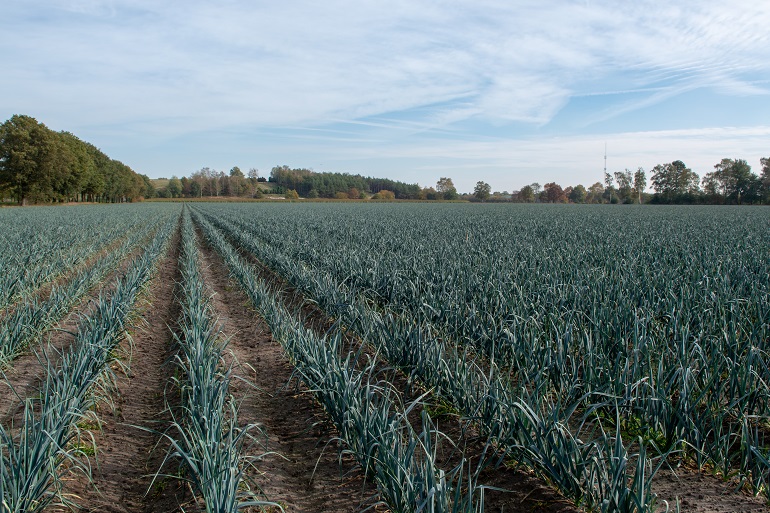Leek Fertilization Requirements

This post is also available in:
This post is also available in:
![]() Español (Spanish)
Español (Spanish) ![]() Français (French)
Français (French) ![]() Deutsch (German)
Deutsch (German) ![]() हिन्दी (Hindi)
हिन्दी (Hindi) ![]() Ελληνικά (Greek)
Ελληνικά (Greek) ![]() Português (Portuguese (Brazil))
Português (Portuguese (Brazil))
Which nutrients are needed for leek growth?
First, you must consider the soil conditions of your field through semiannual or annual soil testing before applying any fertilization method. No two fields are the same, nor can anyone advise you on fertilization methods without considering your soil’s test data, tissue analysis, and crop history of your field. However, we will list the most common leek fertilization schemes many farmers use.
Leek is generally considered a medium to high nutrient-demanding crop. Depending on the nutrient concentration and availability on the field soil, leeks require approximately per season 125-223 pounds of Nitrogen (N) per acre and 100-120 pounds of phosphorus and potassium per acre (140-250 kg N per hectare, 112-134 kg P and K per hectare). However, in some cases, there might be a higher demand for potassium (up to 200 kg sulfate of potash per hectare or 180 lb/acre). The grower can perform a plant tissue analysis to ensure the nutrients are available and successfully absorbed from the crop. In this case, the nutrients in the sample should exceed: 2% for N, 0.2% for P, 1.5% for K, and 0.2% for S. Additionally, Mn should be above 10 ppm, Zn above 15 ppm and Fe above 50 ppm, in order to be at adequate range levels.
Fertilizers from organic sources (like manure) supply the crop with the nutrients needed and build your soil, improving its health and characteristics compared to fertilizers or inorganic sources. Nowadays, commercial growers use both liquids and granular fertilizers for leek cultivation. Some farmers have reported that they start by applying their base dressing by applying 30-80 tons per hectare (or 12-33 t/acre) of well-rotted manure 3-4 months before planting. In case the minimum dose of manure is used, the farmer can also add 100 kg per hectare (90 lb/acre) of a Nitrogen-Phosphorus-Potassium fertilizer type 11-15-15, about 1 month before planting. Another option is to incorporate 1,000 pounds of a 5-10-15 (+5% sulfur) fertilizer per acre before planting (or 1.12 tons per hectare).
After the initial fertilization before or at planting, farmers need to supply their plants with complementary amounts of nutrients in order to maximize leeks’ yield. One option is to apply a side-dress with 200 pounds per acre of Ca(NO3) every 4-6 weeks. Alternatively, depending on each field’s nutrient needs, the farmer can apply 110-120 lb of a 21-0-0 fertilizer per acre (123-135 kg/hectare) in mid-May (late spring) and once more in late June.
Like other Allium species, leeks also need copper, zinc, magnesium, manganese, and molybdenum. As a result, before planting, and depending on the soil testing results, the leek farmer may also apply the following:
- 50 kg/ha magnesium sulfate (or 45 lb/acre)
- 20 kg/ha manganese sulfate (or 18 lb/acre)
- 18 kg/ha copper sulfate (or 16 lb/acre)
- 18 kg/ha zinc sulfate (or 16 lb/acre), or/and 4 g (or 0.01 lb) per L for spray application in case of deficiency
- 2 kg/ha sodium molybdate (or 1.8 lb/acre)
However, these are just some examples of fertilization patterns that should not be followed by anyone without doing their own research. Every field is different and has different needs. Checking the soil condition and pH is vital before applying any fertilization method. You have to consult your local licensed agronomist.
References
- https://www.agric.wa.gov.au/leeks/growing-leeks-western-australia?page=0%2C2
- https://www.ontario.ca/page/leek-production
- https://datcp.wi.gov/Documents/mk_fc_82_web%20pdf%20-%20Adobe%20Acrobat%20Pro.pdf
- https://extension.uga.edu/publications/
- https://extension.usu.edu/yardandgarden/research/leeks-in-the-garden
15 Interesting Facts about Leeks
Leek: Info, Facts, Nutritional Value & Health Benefits
Leek Plant Information and Variety Selection
Commercial Leek Farming – How to Grow Leeks for Profit
Leek Soil Requirements, Soil Preparation, and Planting of Leek
Leek Water Requirements and Irrigation Systems
Leek Fertilization Requirements








































































